|
Getting your Trinity Audio player ready...
|
Established in 1980
Channel Islands National Park, California’s own version of the Galapagos in Ecuador, is home to an incredible variety of unique plants and animals living in a lush and picturesque setting. You can explore the area by going for hikes, paddling on the waters, or scuba diving – something for everyone to enjoy!
We all dream of life on a tranquil island from time to time. It’s easy to drift off and imagine a world without crowded highways and cellphone towers. But it seems like a faraway place, expensive and time consuming to get to.
Not true, however, when you consider that Channel Islands National Park is just 14 miles from Santa Barbara, California. In one short ferry ride, you can go from the hustle and bustle of crowded cities to an uninhabited landscape of grass and trees by the sea.
Are you daydreaming yet? We put together this travel guide to the Channel Islands to fuel your imagination. It contains all the reasons we love California’s most isolated National Park, along with all the insider info you need to explore it. Whether you’re planning a trip already or have never even heard of Channel Islands National Park, this is the place to start your next adventure.
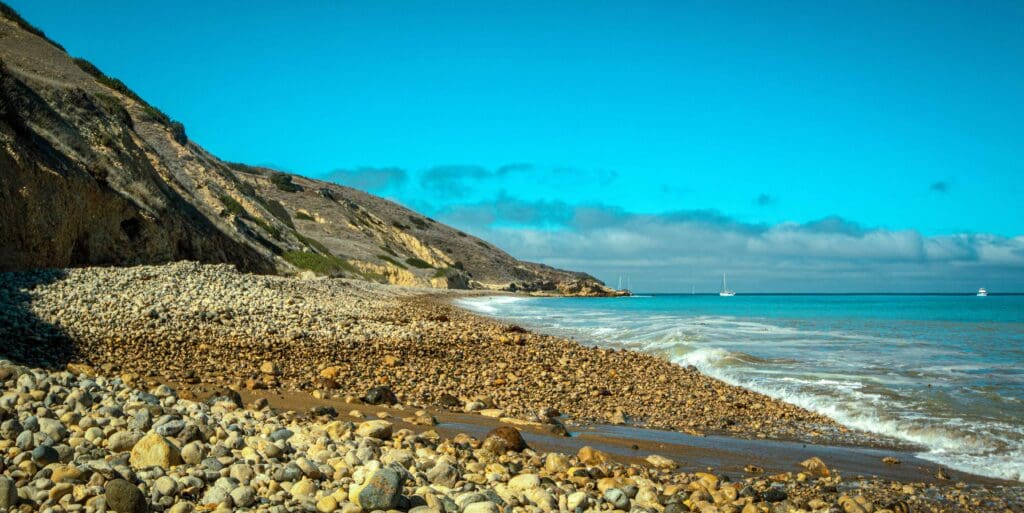
Rocky beach at Yellowbanks bay on Santa Cruz Island in the Channel Islands National Park.
Underwater Mountains
Originally, the Channel Islands were part of the California Coastline. Geological evidence tells us that they were the western reaches of the Santa Monica mountains. This range is formed by a gigantic anticline, a wrinkle in the earth’s crust.
Beneath the surface, you can see rocks of every kind dating back to the Earth’s infancy. We see evidence of volcanism and metamorphosis, leaving minerals like tuff and basalt to be worn down by saltwater and wind.
During the last ice age, when sea levels were lower, the islands were connected in a single island called Santa Rosae. Santa Rosae would have measured 78 miles from end to end, and only five miles from shore. The chain of islands we see today are the former peaks and high points of Santa Rosae.
As the ice started to melt off, roughly 11,000 years ago, the ocean rose. Water crept up, separating the mountaintops. Whatever people or animals had swam to the islands from shore were now more or less stranded.
Archaeology and History
Re-writing the Textbooks
Ancient human history in the Channel Islands is a bit of a mystery. Conventional knowledge tells us that people first migrated to North America around 10,000 years ago, by way of the Bering Strait.
However, scientists have found human remains and artifacts on the Channel Islands that call all of that into question. Archaeological sites on the islands, mostly found in caves, show a snapshot of early life.
These ancient islanders lived on fish and shellfish, and even had boats that they used to traverse the coasts, and possibly make trips to the mainland.
But what’s even more interesting is how old they are. Archaeologists have found signs of human habitation on the Channel Islands dating back as far as 37,000 years ago. This calls our entire understanding of human history in the western hemisphere into question.
Did ancient North American native peoples actually cross the Bering Strait on foot, or is the real story much more complex? The short answer, at least for now, is “we’re not sure.”
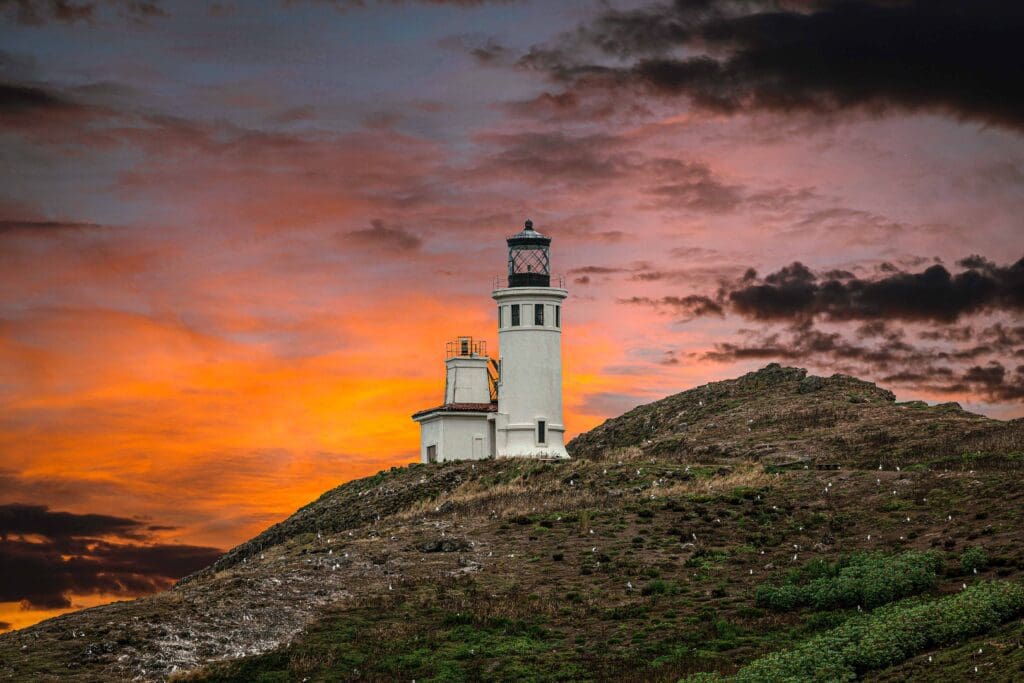
Anacapa island lighthouse with nesting seagulls and sunset sky at Channel Islands National Park.
Tiny Giants
We also see hints of a very different world on the islands. Humans weren’t alone on Santa Rosae; they shared the rocky hills with pygmy mammoths.
It’s shocking to think that, at some point in history, a full-grown 20,000 pound Columbian mammoth swam out into the ocean, and by some miracle, arrived at Santa Rosae. But that’s exactly how the pygmy mammoth came to be.
Burnt mammoth bones, dated to 30,000 years ago, suggest that early people hunted and ate these mammoths as part of their regular diet.
Modern Native Peoples
When Spanish and Portuguese explorers arrived, they found the Chumash people inhabiting the Channel Islands. Juan Rodriguez Cabrillo described as many as 21 native villages on the three largest islands.
The culture of the local Chumash appears to have been highly developed, with strong social structures; tradespeople and artisans, hunters and fishermen, and shamans all occupied different rungs on the social ladder. The Chumash had a strong command of sea travel, using long man-powered boats similar to canoes to fish and travel.
But, as is almost always the case, the arrival of the Spanish brought the downfall of native society. Europeans introduced disease into the Channel Islands, which decimated their populations. The rise of Catholic missions along the coast depleted natural resources that the natives depended on. And by 1820, the few remaining Chumash on the islands had migrated to the mainland.
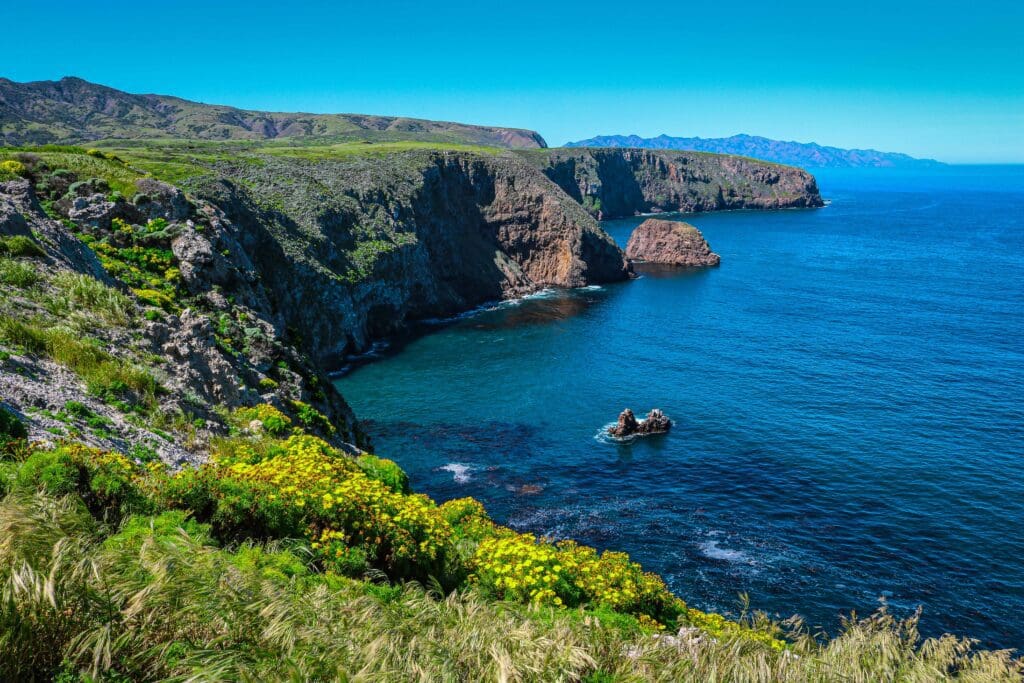
Santa Cruz Island, Channel Island National Park.
The Formation of the Park
While the neighboring coastline became a bustling hive of human activity, the Channel Islands stayed quiet. They were sparsely visited and stayed mostly untouched from the time that the Chumash left. In 1938, they were named a National Monument; filed away and mostly forgotten. That is, until they were threatened by a massive ecological disaster.
In 1969, an offshore oil rig blew out just six miles from the California coast. The resulting spill was, at the time, the largest in US history. Tides carried the 200,000 gallons of crude oil, which flowed in waves, to the shore of the Channel Islands. Thousands of birds were killed, and dead marine mammals washed ashore for months.
In the wake of this natural disaster, legislators decided to take action. The five islands currently incorporated into the park, as well as a good deal of ocean surrounding them, were incorporated into a National Park under Jimmy Carter in 1980.
The park’s stated purpose is “to protect and connect the public to the nationally significant scenic, wildlife, marine, ecological, historical, archaeological, cultural, and scientific values of the Channel Islands.” Today, all eight of the islands are biosphere reserve under UNESCO. In addition, three quarters of Santa Cruz Island is owned by the Nature Conservancy, who manages it as a protected wilderness.
Island Ecology
The ecosystem of the Channel Islands brings up a lot of questions. Why are there so many marine mammals here? Why are all of the land mammals smaller than normal? Why would a mammoth risk swimming across the open ocean just to end up here?
Ecology is often called the economics of nature. The answers to all of these questions are more or less the same: supply and demand.
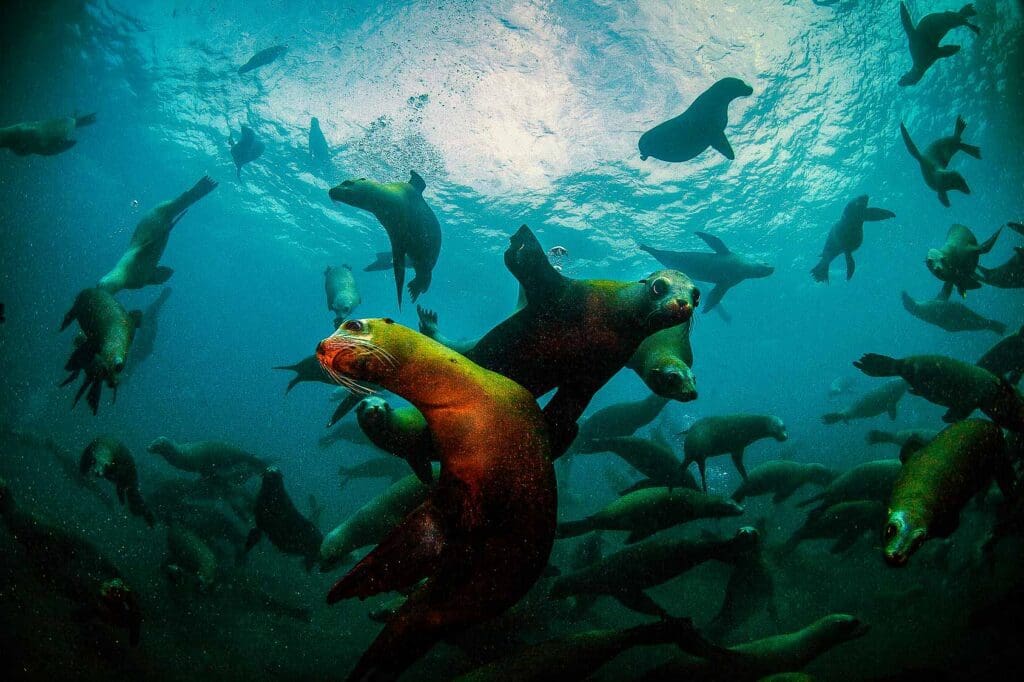
California Sea Lions (zalophus californianus) swimming underwater off Anacapa Island in Channel Islands National Park, California.
Why Did They Come Here?
Any time we see a land animal on an island, we’re left wondering how its ancestors got there. We get hints of epic voyages worthy of the big screen. A lone mammoth, dog-paddling against the swells into the cold, open ocean, not knowing if it will drown. A bat caught in a hurricane that miraculously survives and wakes up on a foreign beach.
But why? Why would an animal go through such an intense, high-risk trek? We can’t always know. In fact, sometimes these things just happen by a freak accident. But the answer usually has something to do with resources.
If you’re a mammoth, living on the mainland, you probably have to compete for food and mates. The more mammoths there are, the less food there is for each one. You spend more of your time fighting for your life and less of it eating and reproducing.
So occasionally, one animal might roll the dice. The risk is high, yes. But if you get lucky, the rewards are colossal. Arriving on an empty island, full of grass, with no competition anywhere.
Smaller Over Time
Another odd phenomenon we see on islands is that land animals tend to evolve smaller bodies. The mammoths that arrived on the island weighed 20,000 pounds. But within a few thousand years, they had shrunk to roughly one tenth that size, around the size of an American bison.
We also see this with the modern-day island fox, which is one of the smallest canines in the world. The island variety evolved from the gray fox, a mainlander that weighs about 30% more.
This process is called island dwarfism or insular dwarfism, and it affects any species (including humans like the Flores Man) that spends a long time in a place with limited resources.
The reason is simple: it takes a lot to feed a 20,000-pound mammoth, and not nearly as much to feed a 2,000-pound one. If you can evolve to have a smaller body, you’re much less likely to starve if there’s not a lot of food around. Or, to put it in economic terms, if you can reduce your cost of living, you have more money in your budget.
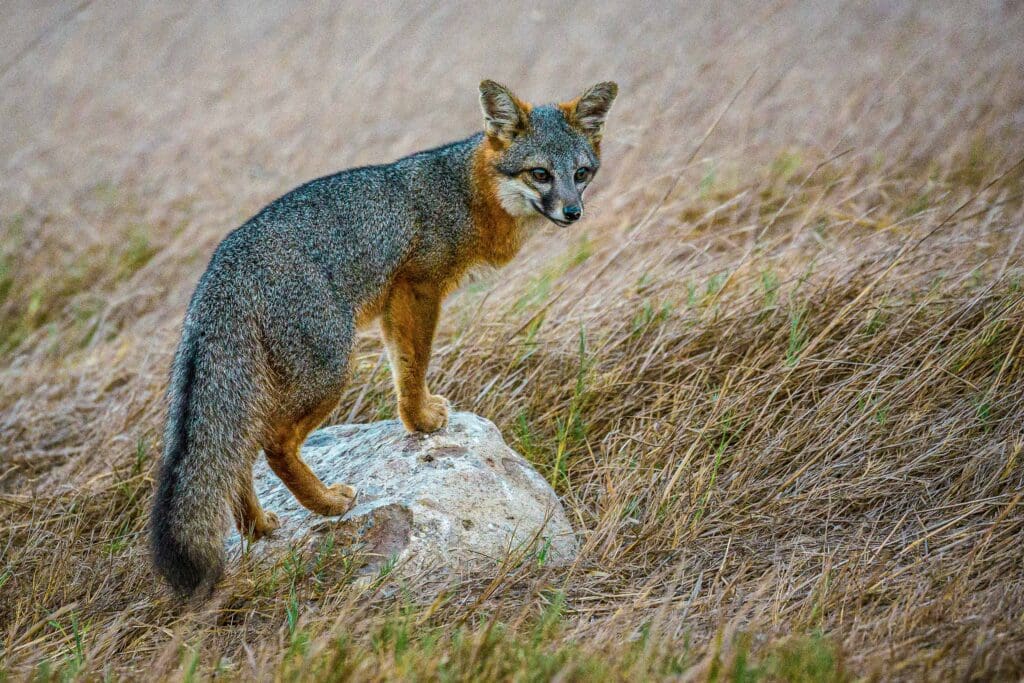
A rare, wild island fox searching for food on Santa Rosa Island.
Seasonal Visitors
The California coast is rich in resources for sea creatures. Changing weather determines where the best place to be is, but there are other factors. Wildlife avoid noisy human activity and pollution, as well as extreme weather.
And wouldn’t you know it, turns out the entire west coast is a very busy place. Except for one tiny chain of islands located a convenient distance from shore, with very stable weather and a consistent supply of food.
In a nutshell, seals, sea lions, whales, and dolphins are all drawn to the islands for the same reasons we are. They crave the solitude and peace of uninhabited places, the temperate weather, and rich natural resources.
Getting to the Channel Islands
Naturally, you can’t just drive to the Channel Islands. But there are a few options for people without boats to make the trip. The park has a single concessionary that runs cruises to and from the islands: Island Packers. Island Packers runs both single day and multi-day trips to all five of the islands, as well as whale watching and birding cruises.
You can expect to pay $50-100 for a round trip to the Santa Cruz, Santa Rosa, and Anacapa Islands. San Miguel and Santa Barbara Island trips are a little more, running over $100 for camping trips. Whale watching cruises go for around $75.
The other option is taking your own boat. This is a perfect short trip for hobbyists who love watercraft.
Whichever way you choose to go, I recommend planning far in advance. You can see the seasons for boat trips on the park’s website.
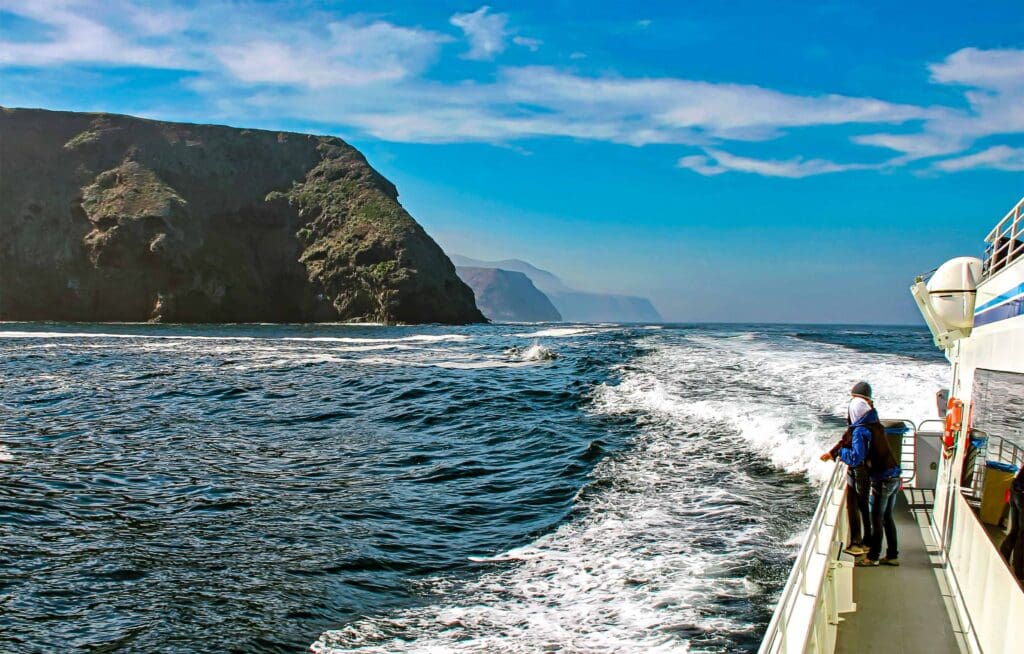
California’s Channel Islands National Park near Santa Barbara is a popular day trip.
Best Times to Visit
Most national parks have a distinct “high” and “low” season. Often, there is a set of ideal conditions for viewing a landscape, and usually that happens in the summer.
But there really isn’t a “wrong” time to visit the Channel Islands. Coastal weather is pretty stable, and the changing seasons here have more of a noticeable impact on seawater clarity and which wildlife species are around.
So, rather than giving you one answer as to when you should visit, I’m going to give you all the reasons to visit during each season.
Spring is when the islands are greenest. The hills fill up with wildflowers, and the sky is full of different seabirds. It’s the start of good conditions for watching seals and sea lions, and gray whale watching runs through April.
Expect some rain, though. The spring months are all above average for rainfall. After April, the precip starts to taper a little.
Summer is the best time for boating. If you’re coming to the Channel Islands to explore by boat or kayak, you’ll have better seas. Blue and humpback whale watching starts around this time, and seals and sea lions start pupping too.
However, this is the high season for visitation. The Channel Islands are typically busiest from June to August.
Fall provides warm, still, clear seas that are great for snorkeling and diving. Ocean temps hover in the sixties, and underwater visibility extends considerably. Fall bird migration is ongoing by this point, which is a definite plus for birdwatching. Elephant seals will start to appear toward the end of fall.
Fall starts to get a little more rainy, especially in October and November. Blue and humpback whales will be gone in the Fall as well.
Winter is a fantastic time to watch for some wildlife. Elephant seals and harbor seals both start pupping in the winter. Gray whales also arrive around December. Several bird species return to nest around this time.
It’s comparatively the wettest and coldest time of year, though. Highs drop into the fifties, which is still balmy depending on who you ask. But rain is much more common.
Top Things to See in Channel Islands National Park
The Channel Islands aren’t what you’d call a “sporty” park. That is to say, it’s not a bucket list destination for adventure sports fanatics, the way Yosemite and Grand Teton are.
The appeal here is more similar to Death Valley or Crater Lake; by which I mean it’s more about just marveling at, and connecting with the landscape.
That doesn’t mean you’ll have nothing to do – in fact, there’s a ton to do here. But if you don’t take some time to slow down and do some nature watching, you’re missing out.
These are the things you can’t miss in the Channel Islands.
Whale Watching
Whale watching is an unforgettable experience. There are three species of whale that frequent the Channel Islands, including the blue whale, the largest animal ever to live. You can spot whales about six months out of the year here. Dolphins and porpoises are also regulars in this area.
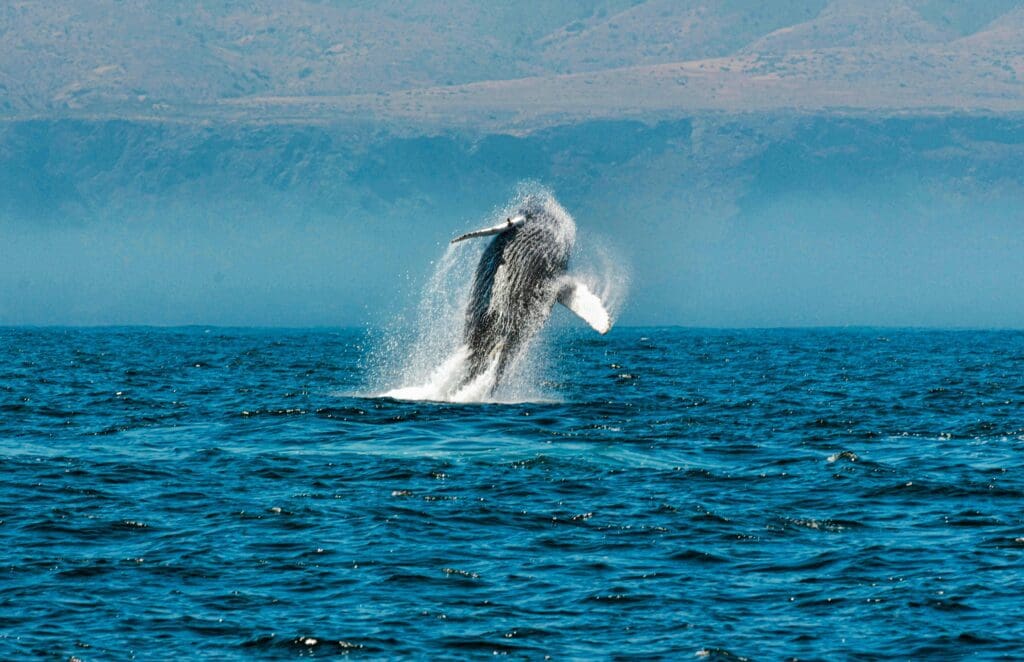
Humpback Whale Breaching off Santa Cruz Island in the Channel Islands.
Seals, Sea Lions, and Elephant Seals
The pinnipeds (seals and sea lions) of the Channel Islands are all pretty amazing. Elephant seals in particular are completely mind-blowing to see. They’re the largest mammals in the United States, weighing up to 4,500 pounds. They’re horribly territorial, loud, stinky, and one of the most fascinating animals you can spot on the islands. Point Bennett on San Miguel Island is probably the single best destination for pinniped watching in the park. You can see tens of thousands of seals and sea lions all in one place here.
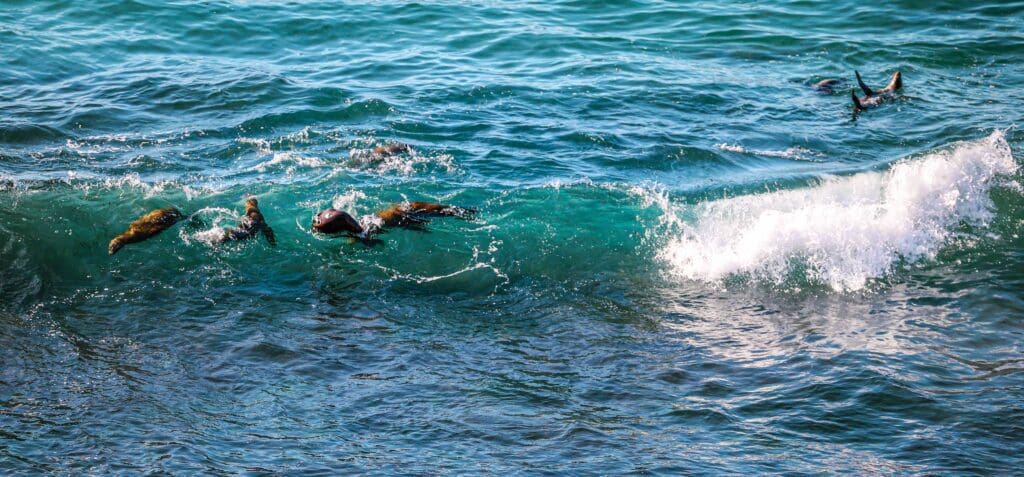
Seals and sea lions riding the waves off San Miguel Island, Channel Islands National Park. Photo by Julie Shipman Photography
Sea Caves by Kayak
One of the coolest adventures to take on in the strange landscape of the channel islands is kayaking through sea caves. Santa Cruz Island is full of fantastic, surprisingly large caves. If you book a tour with a private guide, you can paddle around the island, exploring these strange, quiet voids beneath the island.
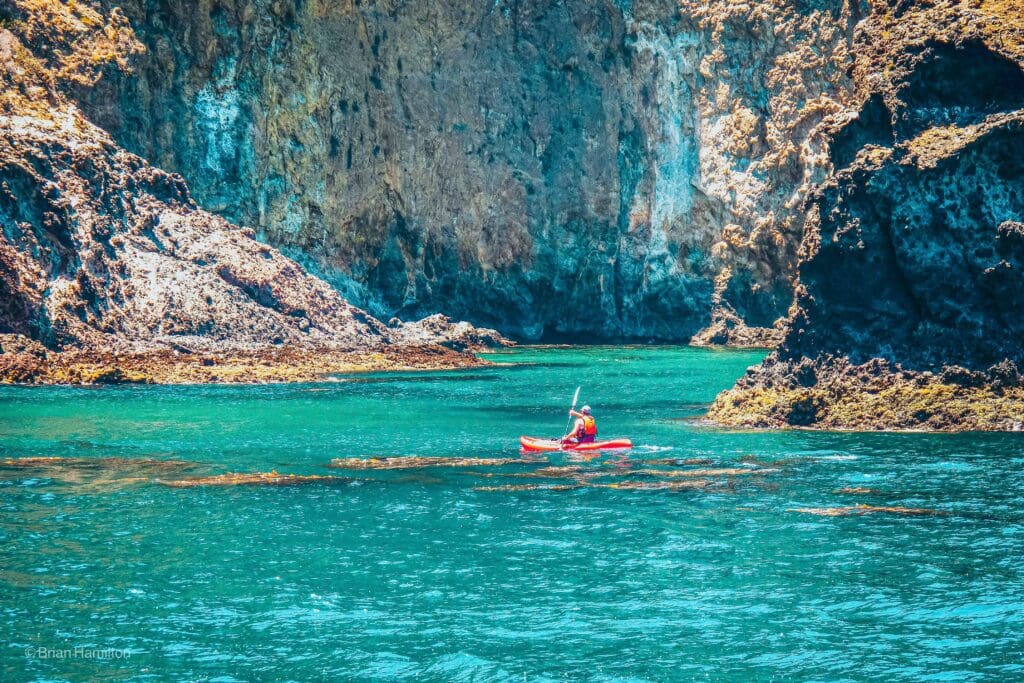
Sea Kayaking at Santa Cruz Island in Channel Islands National Park.
Snorkeling and Diving
For many visitors to the Channel Islands, snorkeling and diving is the main attraction. If you weren’t aware, the Channel Islands is one of the best diving destinations in the US. The islands are home to kelp forests, reefs, and a ton of fish and marine animals to see. I’ll get into more detail on this in a minute, but when planning a trip to the Channel Islands, don’t even think of leaving your snorkel at home.
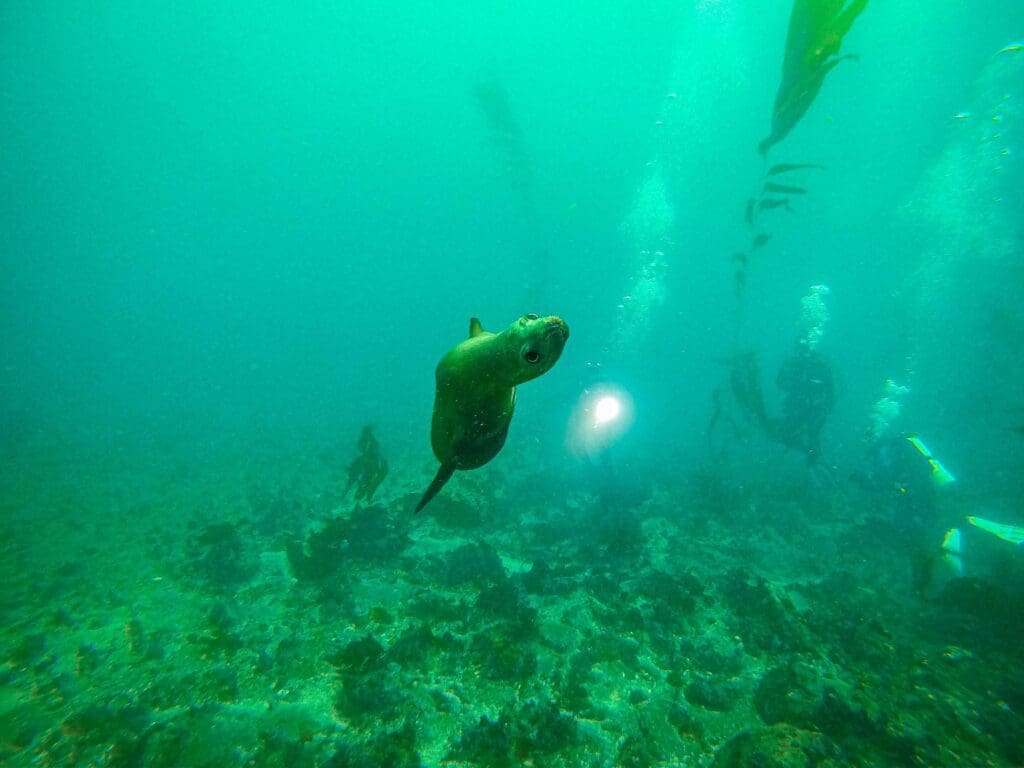
Sea lion is playing with scuba divers in the kelp forest in the Channel Islands.
Inspiration Point
There are a lot of scenic seaside hikes in the Channel Islands, but one stands out above the rest. Inspiration Point on Anacapa Island is a National Geographic-worthy photo op. It’s one of the smallest islands in the chain, and easy to overlook. But if you’re the type to go the extra mile for a stunning view, this should be on your list.
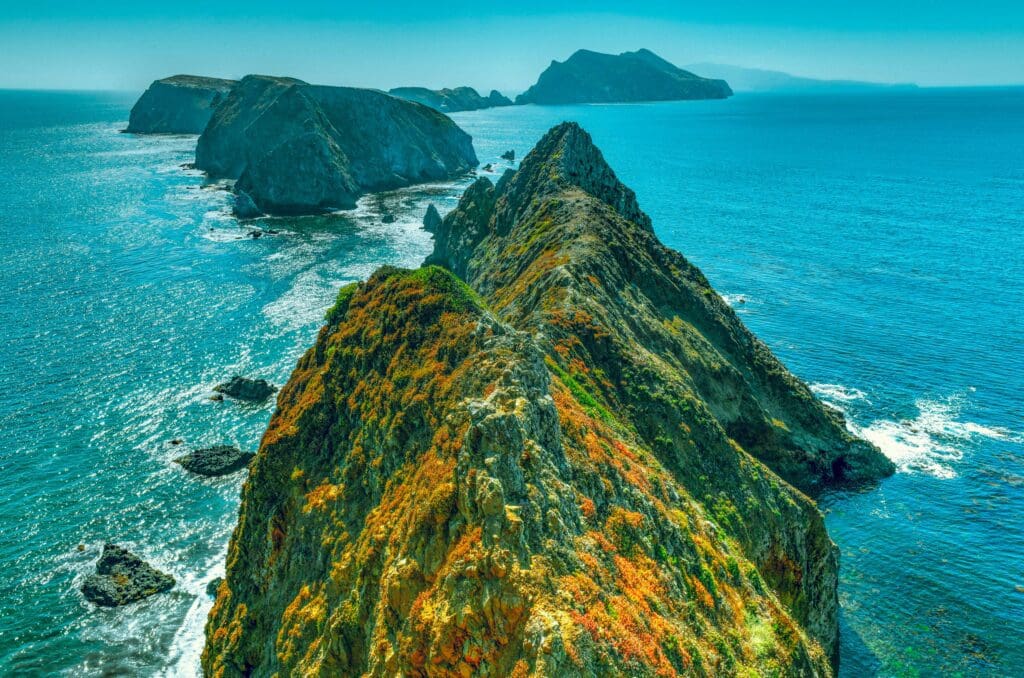
View from Inspiration Poin on Anacapa island, California in Channel Islands National Park.
Hiking the Channel Islands
Each of the islands has a few hiking trails, and they’re all winners. For simplicity’s sake, here are a few trails on each island.
Santa Cruz Island is where most visitors go when they take the ferry to the park.
Cavern Point is a short but sweet, mostly flat trail along some pleasant seaside cliffs.
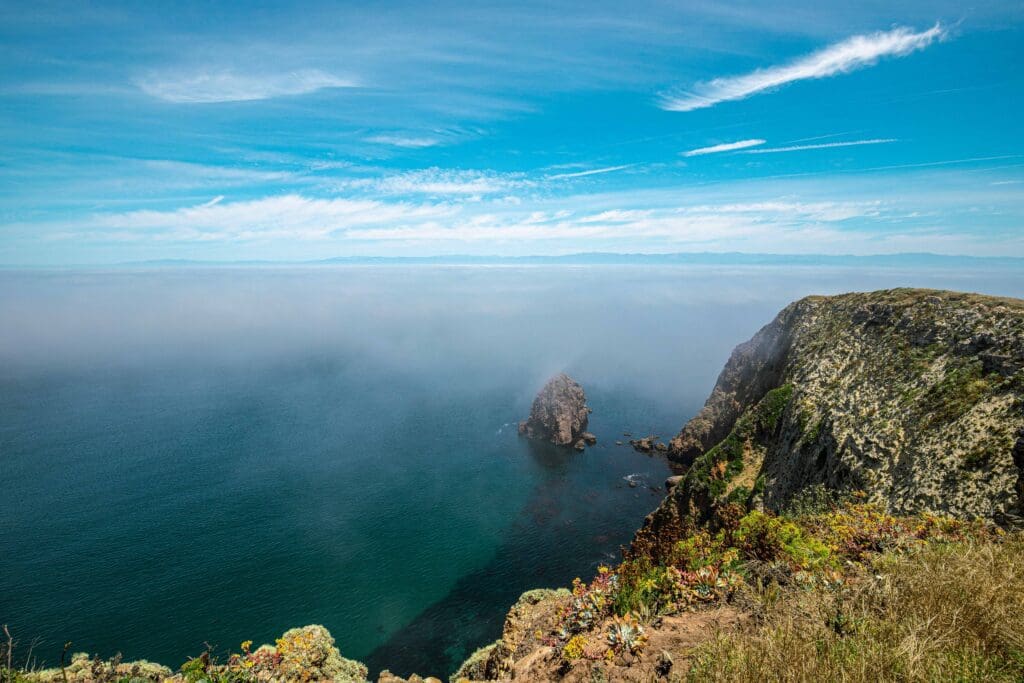
Stellar views from the Cavern Point Loop hiking trail on Santa Cruz island in the Channel Islands National Park.
Potato Harbor is a slightly longer (5.5 mi) out-and-back that overlooks Santa Cruz’s north coast, haystack rocks, and is great for wildlife watching.
Smuggler’s Cove traverses from the north to south coast. It covers 7.7 miles and about 1,500 feet of elevation, which feels like a lot more in the summer sun. But it’s a very rewarding journey, with sweeping views of the island’s interior.
Santa Rosa Island has the most trails of any island in the chain.
These include a few multi-day treks, like the East Point Trail, a solid 20-miler that is often very quiet and free of other visitors. It ends at Ford Point, a tranquil beach, and passes several water sources.
Torrey Pines is shorter, and accessible from either the north or south. It crosses through a few different biomes, canyons, and beaches.
Black Mountain Trail climbs from the beach to the summit of a high point overlooking a lot of the island’s interior, capped with a small cloud forest.
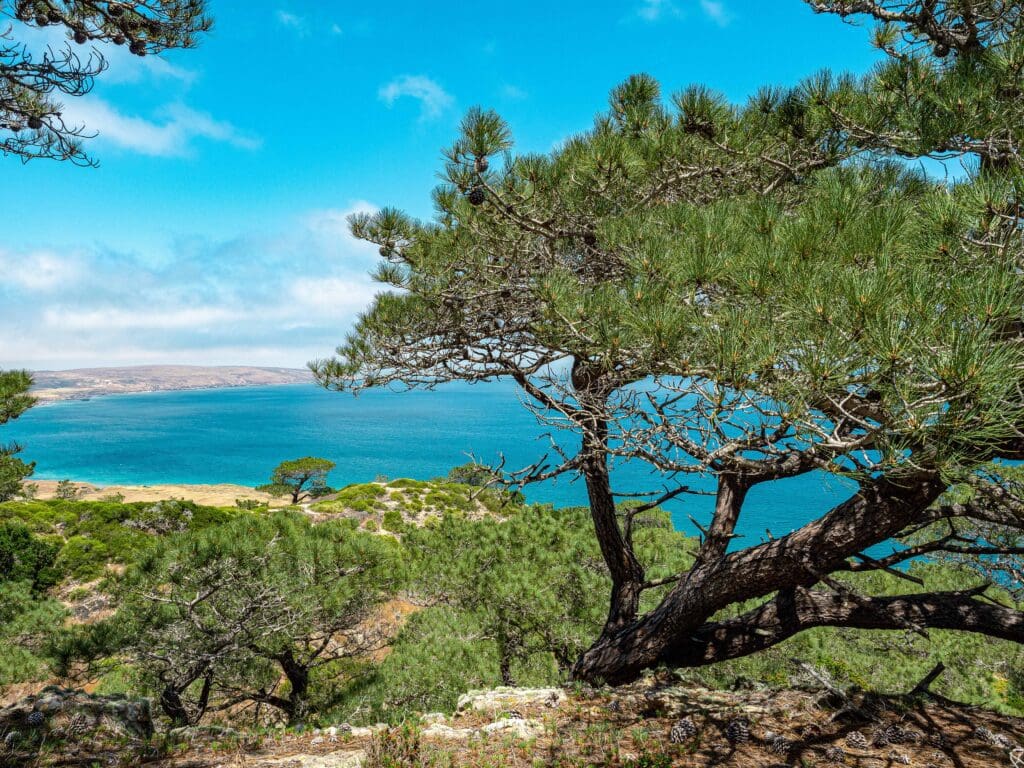
Torry Pines trail near Ranch at Bechers Bay Pier on Santa Rosa Island, Channel Islands National Park.
Anacapa Island is the closest to the California coast. It’s small, and only has one trail, but that trail is probably the best in the park.
The East Anacapa Island Trail is a nonstop ride through some of the best viewpoints in the Channel Islands. It starts at Landing Cove, and passes Cathedral Cove on the way to Inspiration Point. The rugged, cliffy character of this island can’t be overstated. It’s almost hard to believe how charismatic this area is.
San Miguel Island is the furthest from shore. It has a few trails which cross over its mostly flat surface to coves and beaches on the north, west, and east shores.
Point Bennet Trail is the longest of these, covering 14.5 miles. It’s best done as a backpack. The route is very enjoyable, often solitary, and features sweeping, moody views of the island’s windswept interior and coast.
Cardwell Point can much more easily be done in an afternoon. It ends at a fantastic beach and is good for spotting wildlife.
Similarly, Harris Point Trail heads along a cliff band to the island’s northernmost point. Rocky cliffs, wildflowers, and greenery are constant along the way.
Santa Barbara Island is the park’s smallest, often forgotten for being so remote from the others. Expect to have a lot of room to yourself, and plenty of things to see.
The Santa Barbara Island Loop is a perfect tour across this quant, green rock. You’ll see almost all of the island’s coastline, wildflowers, and wildlife as you overlook the sea from high above.
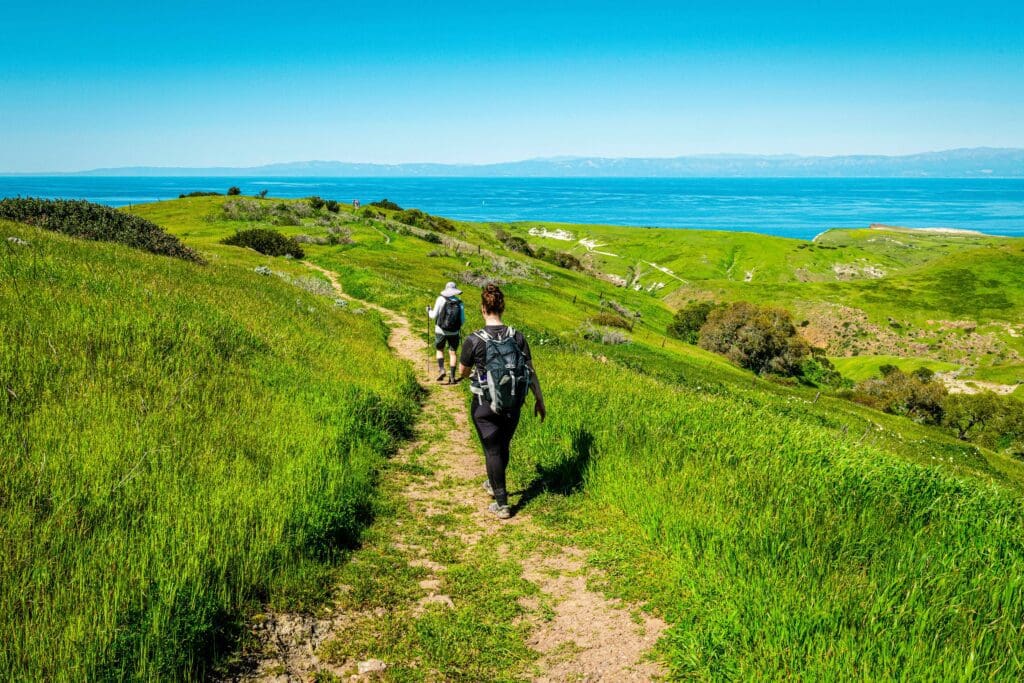
Hikers on Scorpion Canyon Loop trail on Santa Cruz Island, Channel Islands National Park, California
Camping
What’s better than a day trip to the Channel Islands? How about waking up to the sound of the ocean, cooking breakfast, and then going on an adventure?
Day trips are all well and good, but getting to overnight on these quaint little islands is an entirely different experience. It’s well worth the effort.
And trust me, there is a lot of effort involved. Campsites can be reserved six months in advance, which means you’ll need to plan at least that far out. Given that the park is a chain of tiny islands, space is very limited. If you want one, you’ll have to compete for it.
Your best bets for finding a spot are Santa Cruz and Santa Rosa Islands, as they have the most sites. Anacapa, San Miguel, and Santa Barbara all have fewer than ten campsites each. But for some, a quieter and more solitary experience is exactly the draw of this sleepy island chain.
Be prepared to pack in all your gear, and be aware that only Santa Cruz and Santa Rosa Islands have drinking water. Most importantly, wherever you camp, pack out whatever you pack in and leave no trace.
Diving and Snorkeling
Aside from hiking, diving and snorkeling are the main activities that bring people to the Channel Islands.
There are essentially two ways to go about exploring the waters around the islands. You can either pack in all your own gear and plan your own dives, or go with a guide. Each has its benefits.
Guided Tours
If you go with a guide, everything will be planned. You’ll be sure to see the best spots around the islands, and you’ll have the added benefit of being able to dive further from shore. For beginner and intermediate divers, this is the obvious choice. Rates generally range from $125 for a snorkeling day trip to $350 for two days of diving.
Self-Guided Snorkeling
If you’d rather be self-guided, be prepared to do a lot of planning and prep. For starters, you’ll probably want to overnight on the islands, so that you have at least a whole day to explore. The Island Packers ferry service limits how much gear you can take with you on the boat; so you probably won’t be able to bring scuba gear.
Best Diving Spots
The two islands people most often snorkel are Santa Cruz and Anacapa. The front side of Santa Cruz (managed by the NPS) is surrounded by good snorkeling. Look for haystacks or rock formations offshore. The best conditions are usually early in the day, before the wind kicks up.
Anacapa’s steep cliff walls, which extend underwater, attract a ton of wildlife and are perfect for snorkeling. On calm days Cat Rock (the haystack off the south shore of West Anacapa) is a perfect spot to explore. If the water is a little rougher, you can check out Frenchy’s Cove on the north shore of West Anacapa.
The other islands also have a lot of potential, and see far fewer visitors. This is both a good thing and a bad thing. You’ll have a lot more room to yourself, but you’ll have to do some investigating from the shore to figure out where the best snorkeling spots are. In general, look for rock formations close to shore or areas with calm water.
Kayaking and Surfing
The Islands by Kayak
There’s something magical about exploring the tiny inlets and beaches of an island on a tiny boat. The Channel Islands’ many coves, beaches, arches, cliffs, and caves make up a dreamlike coastal landscape. Paddling around it makes the world feel small, and makes you feel small in it.
Suffice it to say that there is a lot more than a day’s worth of adventure to be had in paddling the Channel Islands coastline. You can hire a guide to take you out on the water for a long day for anywhere from $135 to $185 per person (plus ferry ride). Guides also offer combined kayak and snorkel tours, which is probably the best way to experience the Channel Islands.
Some people take the assignment of “kayaking the Channel Islands” to another level, and kayak to the islands from shore. This is a pretty adventurous undertaking; Anacapa Island, the closest to the mainland, is still 11 miles away. Unfortunately, because of the ferry’s gear limitations, this is probably the only way to get your own kayak to the islands.
Surfing
While the Island Packers ferry won’t transport stand-up paddleboards, they will let you bring a surfboard (as long as it’s shorter than eight feet). Santa Cruz, Santa Rosa, and San Miguel Islands all have good waves. The north shores are best in winter and spring, while the south shores peak in the summer and fall.
One of the most popular spots in the park is Water Canyon Beach to Skunk Point, on the northwest corner of Santa Rosa Island. It’s easily accessible from the ferry, right next to Water Canyon Campground, and forms a nice left break. It’s one of the most no-fuss spots on the islands to surf.
Santa Cruz Island has some awesome beaches (like Smugglers Cove) on the south shore. You’ll just have to hike over the island to get there. Cuyler Harbor on San Miguel Island is a lot more manageable by comparison. The ferry drops you off right next to a campground, and the beach gets good waves early in the season.
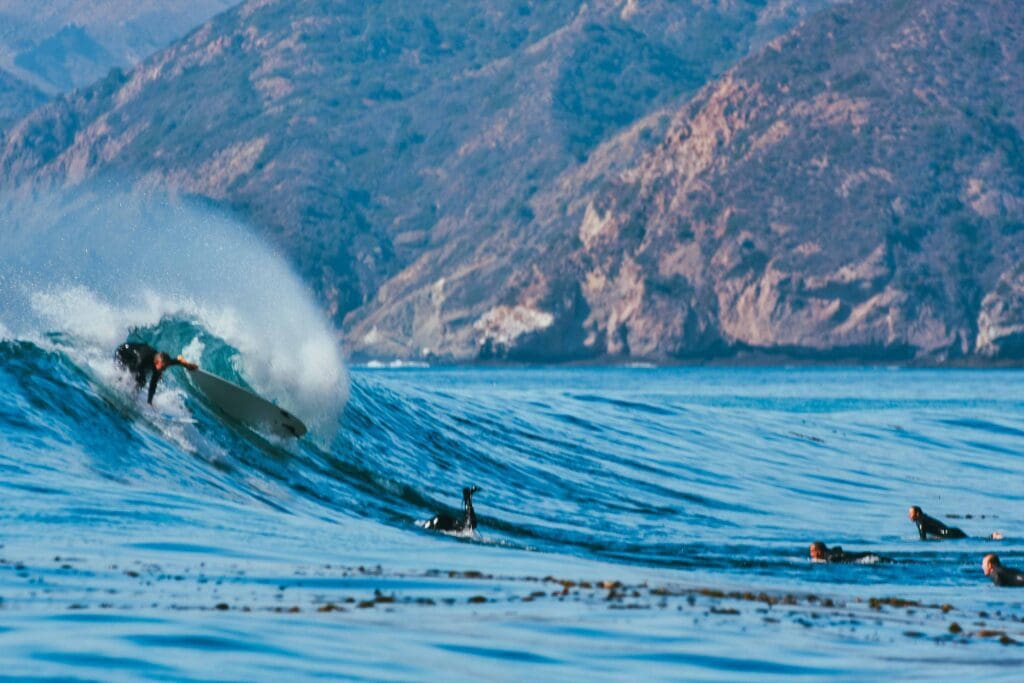
Surfing in Channel Islands National Park.
Natures Watching
The wildlife are the star of the show in the Channel Islands. It’s almost impossible to take a hike in the park without spotting some kind of interesting bird, mammal, or sea creature.
Before you go, here are some quick tips:
- Bring binoculars
- If you’re unfamiliar with birds, or bird ID, check out the Merlin Bird ID app. It’s probably the handiest pocket resource for wildlife watching ever created
- Look in places you wouldn’t expect, at times you wouldn’t normally try. Dawn and dusk are always safe bets, but you never know when you might get lucky.
- Check a tide chart to see when the best times to go tidepooling are
While on the islands, these are a few things to be on the lookout for.
Whales and Dolphins
You can spot four whale species around the Channel Islands at different times of the year. Grays migrate along the southern California coast in the winter. Blues, humpbacks, and minke whales are more common during the summer. Dolphins (as many as 24 species of them) are common year-round.
If you really want to improve your odds for spotting whales, go on a whale cruise with Island Packers. While it’s possible to see them from the coast, you’re much more likely to spot something interesting while covering a large area. Whale cruises run around $40 per person.
Sea Lion and Seal Spotting
It’s hard not to love pinnipeds. They emanate personality from hundreds of yards away, and are always interesting to watch.
Each island attracts at least two species of pinnipeds: the California sea lion and harbor seal. But if you want to see more types (including elephant seals), you’ll have to get away from Anacapa and Santa Cruz Islands. You can find elephant seals in rookeries and on beaches on Santa Rosa, San Miguel, and Santa Barbara Islands.
Of these, San Miguel is definitely the best place to see pinnipeds. It has the most species, including a few very rare species of fur seals, and a lot of places to spot them. San Miguel Island is visited by more species of pinnipeds than any other place on Earth. Most importantly, they show up in huge numbers. Tens of thousands of sea lions and elephant seals visit San Miguel Island to breed every year.
What this results in is huge sand spits covered as far as they eye can see in loud, blubbery mammals. It’s one of the largest congregations of wildlife in the world. The park offers guided hikes with rangers that I highly recommend if you want to learn more about seal and sea lion ecology.
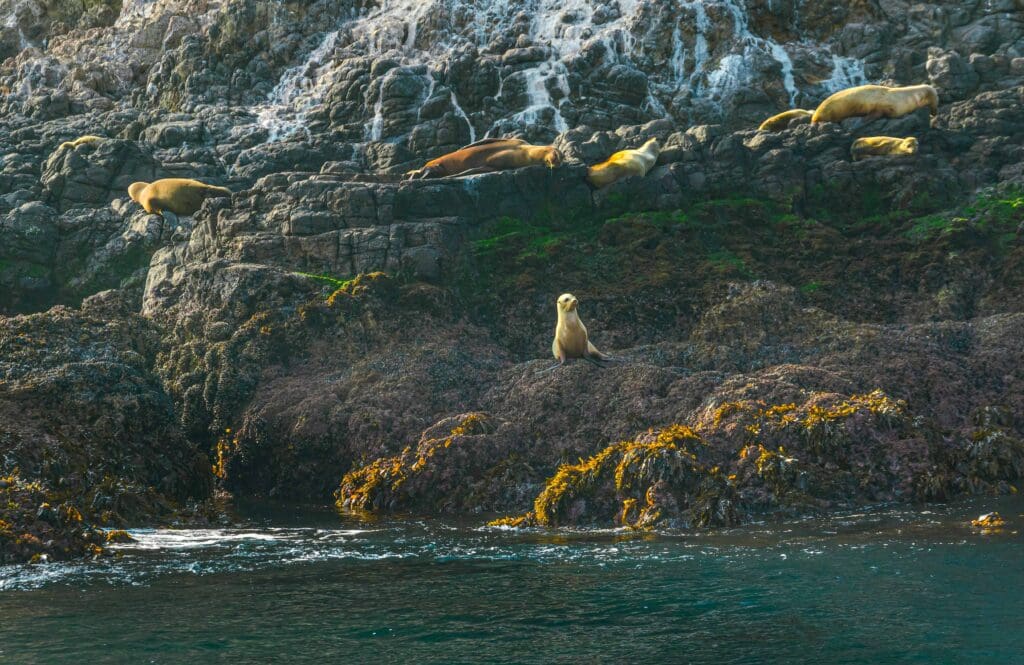
California sea lion (Zalophus californianus), Channel Islands National Park.
Birds and Land Animals
The islands are also hotbeds of diversity for migratory and resident bird species. There are a shocking amount of groups present here, from shorebirds to owls to hummingbirds to woodpeckers to shrikes. You’ll probably see some familiar faces, like wrens and nuthatches. But the islands also see some very exotic visitors. Puffins and albatross have even been seen in the Channel Islands.
Comparatively, the land animals of the Channel Islands are much less diverse. But, because it’s such a small area, you have a good likelihood of seeing something interesting. One of the common characters visitors see is the Island Fox. These critters are endemic to the Channel Islands – found nowhere else on earth.
There are also a fair few reptiles and amphibians on the islands. Salamanders and frogs creep and crawl around the few shallow streams that trickle out of the mountains. Drier places are home to several lizards and snakes. Be observant while hiking. Reptiles like to bask on trails and exposed rocks in the sun.
Tidepooling
The tidepools in the Channel Islands are very isolated and protected, making them some of the best in California. Spending some time at a tidepool, you’re guaranteed to see some amazing, colorful, and strange species. Just be sure not to step on them.
Each island in the chain has a fairly accessible tidepooling spot. Frenchy’s Cove on Anacapa, Smuggler’s Cove on Santa Cruz, Becher’s Bay and Southeast Anchorage on Santa Rosa, and Cuyler Harbor on San Miguel are all top notch. Consider picking up a guidebook to local species before heading out.
The World In Miniature
The Channel Islands are one of the most unique National Parks in the US. It’s especially different from one of the large inland parks in the country, that seems to stretch on forever.
In contrast, the Channel Islands are almost like a landscape in a snowglobe. The world feels smaller and more quaint here. Tiny animals run along tiny mountain ridge lines. There are no vast expanses to disappear into, no huge stretches of unexplored terrain.
It’s all the character of southern California; the mountains, the coast, the beach, the sea; all jam-packed into a charismatic little package. What more could you really ask for?








